Baobab juice is the absolute winner among healthy and tasty beverages, capable of knocking your socks off in a minute. Not only it tastes incredibly good, but it also has so many health benefits that it’s almost incomparable to any other drink out there.
This amazing juice might be one of the oldest beverages on earth. A miraculous drink is made from the fruit pulp of the ancient baobabs, whose presence on earth can be traced to prehistoric times before splitting the continents, more than 200 million years ago.
Yes, baobab juice is probably as old as mankind.
Growing in dry and extremely harsh savannah conditions, where not many species can grow, this amazing giant is thriving. Being called a tree of life could be an understatement; baobab is a king of life.
In this post, we are going to explore the amazing origins of baobab juice, its incredible nutritional facts, and mindblowing health benefits.
And, of course, we’ll show you an easy recipe for how you, too, can make a delicious organic baobab juice at home.
There are people who stack their suitcases with clothes when flying home from Africa, and also, there are crazy people who stuff every empty spot in their suitcases with baobab pulp. Because besides elderflowers, spruce tip syrup, and helichrysum oil, baobab juice is a real treasure to have at hand. p.s. We love making baobab ice cream and baobab bars, too.
- Mighty baobabs, the timeless giants
- What exactly is baobab juice?
- Baobab juice and its incredible nutrition facts
- Remarkable benefits of baobab juice
- The perfect blend of ingredients in baobab juice
- How to make baobab juice
- Baobab juice variations & ideas
- How to store it
- Where to buy ingredients for baobab juice
- FAQ
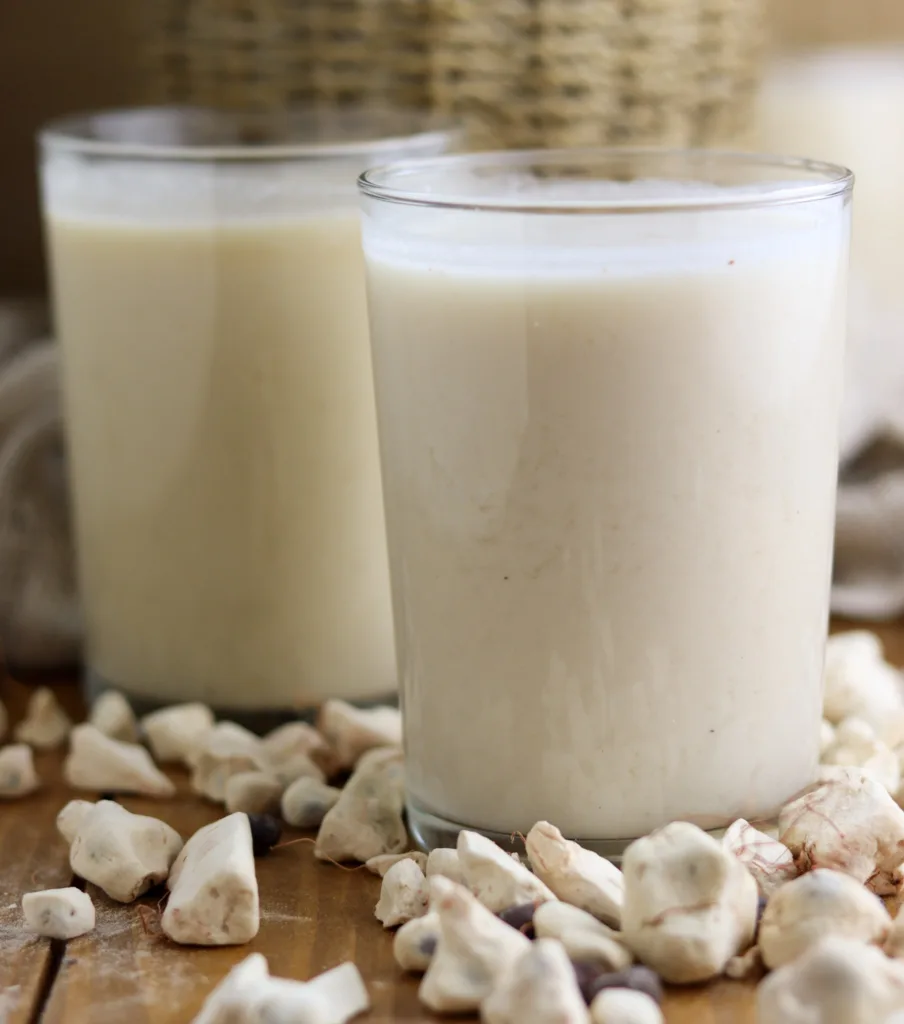
Mighty Baobabs, the timeless giants
The magnificent baobab (Adansonia Digitata) habitat lies in the hot, dry scrublands and savannas. It can be found in many remarkable locations, from the sun-drenched savannas of Senegal to the windswept plains of Madagascar. Native to Africa, Madagascar and Australia, baobabs have been introduced to India and South America as well.
According to stories, it is believed that the majestic baobab trees were personally planted by God. An intriguing tale suggests that when the baobab tree was initially planted, it still had a habit of strolling around. To solve the problem, God decided to replant it with its roots pointing up to the sky.
Baobab is one of the oldest living flowering plants on earth. It can grow from 5 to 30 meters high; its trunk can reach 11 meters or even more. An ancient baobab tree in Zimbabwe is so huge that actually forty people can hide inside. Quite amazing, isn’t it?
These magnificent trees are actually succulents and can store a large amount of water inside their trunks. Baobabs can survive up to three years without a drop of water, and a single tree can store up to a jaw-dropping 26,000 gallons (100.000 liters). That’s why baobabs are often called trees of life. They indeed are.

Carbon dating shows that these giants can live up to 3000 years. The oldest baobab grows in South Africa, and it’s more than 1840 years old. Despite splitting twice and once already collapsing entirely, it still continues to live.
Interestingly, once these trees really die, they decompose from the inside out and suddenly disintegrate. It’s like they just vanish, leaving behind only a big pile of fibers.
Baobabs are believed to possess mystical powers and are all over Africa seen as very special and sacred. Sub-Saharan villages were often formed around old baobab trees, which are still seen even today. Old stories reveal that the spirits of the ancestors used to visit and live in baobabs. It is said one can feel them in the branches. Rituals are performed under the tree, and simple offerings are given to the spirits, which are often asked for guidance, good fortune, success and long life.
The Adansonia digitata tree, named after the surgeon Michel Adanson, who first discovered it in 1749 in Senegal, is still very common in the sub-Saharan region.
But sadly, in the last few years, baobabs are said to be mysteriously dying all over Africa. It’s suspected the reasons are rising temperatures and inevitable climate change. Nine of the thirteen oldest known baobabs and five of the six largest baobabs in the world have died in the last 12 years.
Moreover, six of the eight types of baobab trees in Madagascar have been included on the International Union for Conservation of Nature’s red list because their habitats have been ruined by over-cultivation.
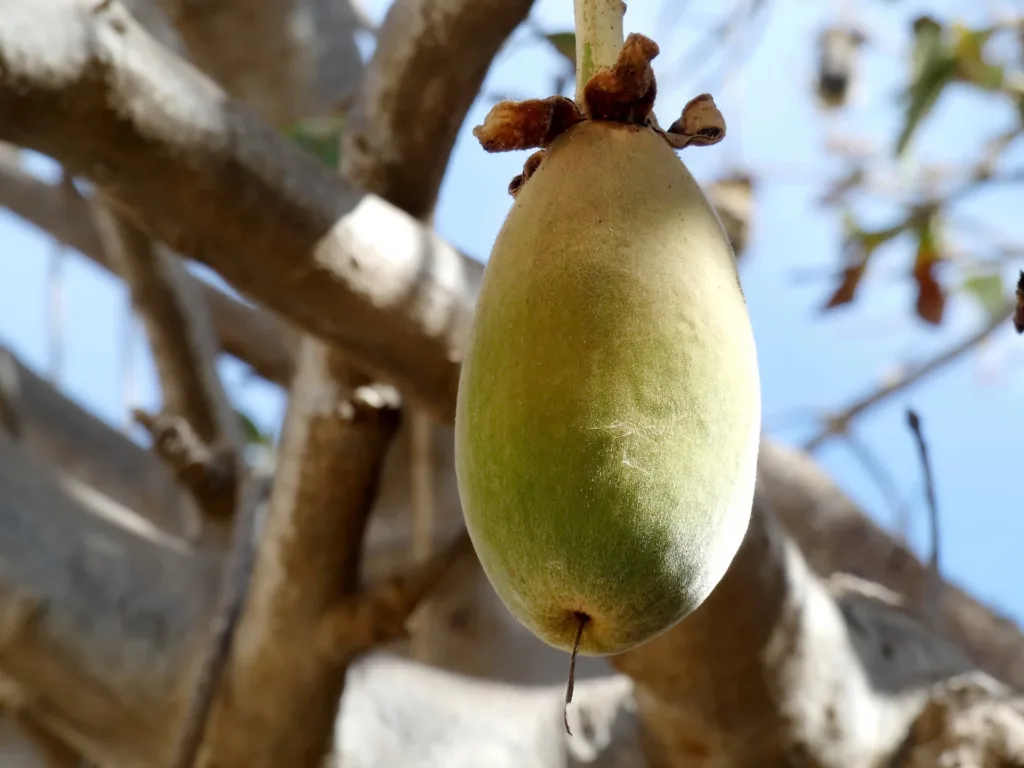
What exactly is baobab juice?
Baobab juice is a beverage made of dry pulp from the inside of the oval-shaped baobab fruit and water.
Shortly before or when the rainy season comes, baobabs start to grow leaves, and remarkably, this leaf growth coincides with the occurrence of flower buds, unfolding in unison. Depending on the area where the baobab grows, its flowers can be pollinated only for about 12 – 18 hours. That’s the job of fruit bats.
When the heavy rainfalls end, silky flowers begin to fade, and slowly, large, greenish-brown orbs that hang invitingly from their branches start growing.
Baobab fruit has a peculiar shape that looks like a velvet oval, and its exterior has a rough and woody texture. As it ripens, it changes color from bright green to a rich brown tone, showing that it’s ready to be harvested.
Inside the leathery exterior, a treasure is hidden — the white flesh of this fruit has a zesty, citrusy taste and is teeming with vitamins and essential nutrients. As the hot summer months give way to the chill of autumn, the baobab tree provides a much-needed source of nutrition for local animals.
Elephants, monkeys, and others take comfort beneath the tree’s branching arms, enjoying the revitalizing white pulp with seeds inside the baobab fruit.
Typically baobab fruits are matured and naturally dried by the warm winds, hanging like oval balls from giant trees in the following months.
At that time, the hard-shelled fruits are collected, and their white pulp, together with the seeds, is extracted and processed to make baobab juice.
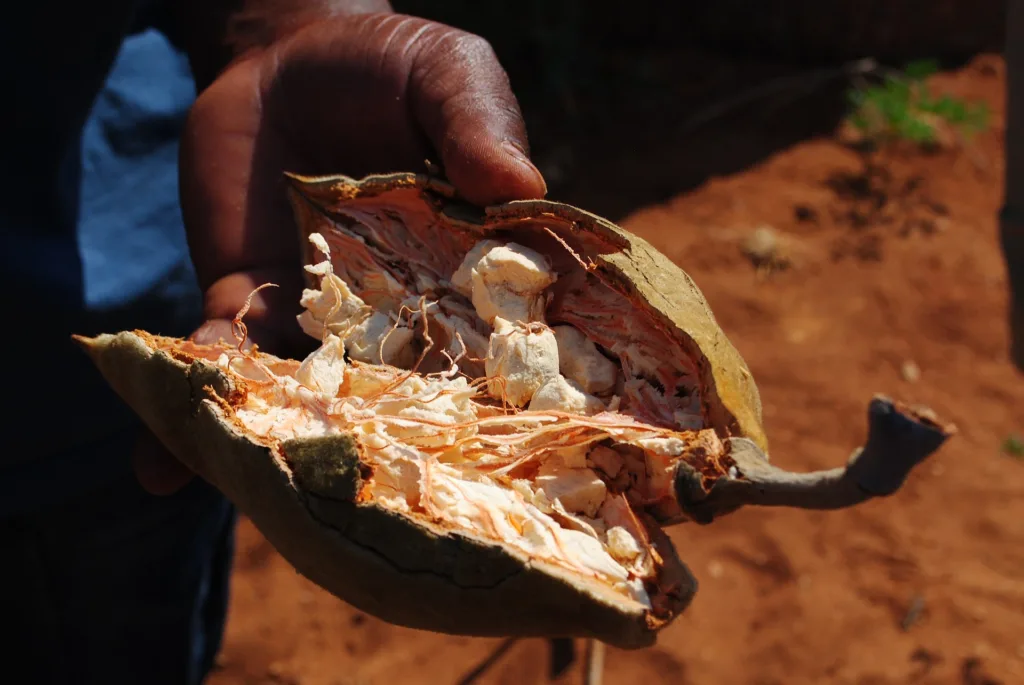
Baobab juice and its incredible nutrition facts
VITAMINS AND MINERALS
Baobab fruit or powder used for making baobab juice has famously spread around the world due to its exceptional nutritional value. Indeed, this magical fruit is not called a superfood for no reason.
Baobab juice is an excellent source of essential vitamins, particularly vitamin C. In fact, it contains significantly higher levels of vitamin C (280–300 mg/100 g) than most other fruits and ten times higher than oranges. Forty grams of baobab pulp will ensure 84 up to 100 percent of recommended daily intake.
Baobab juice is also a tremendous source of vitamin B. The vitamin B family is made up of water-soluble vitamins, and baobab powder has several of them, such as Vitamin B1 (thiamine), Vitamin B2 (riboflavin), Vitamin B3 (niacin), Vitamin B6 (pyridoxine), and Vitamin B9 (folate).
It is also said that baobab contains more iron than a steak. Baobab fruit pulp can provide anywhere between 3 to 6 milligrams of iron per 100 grams, which can be a significant portion of the 8 to 18 milligrams recommended for adults daily.
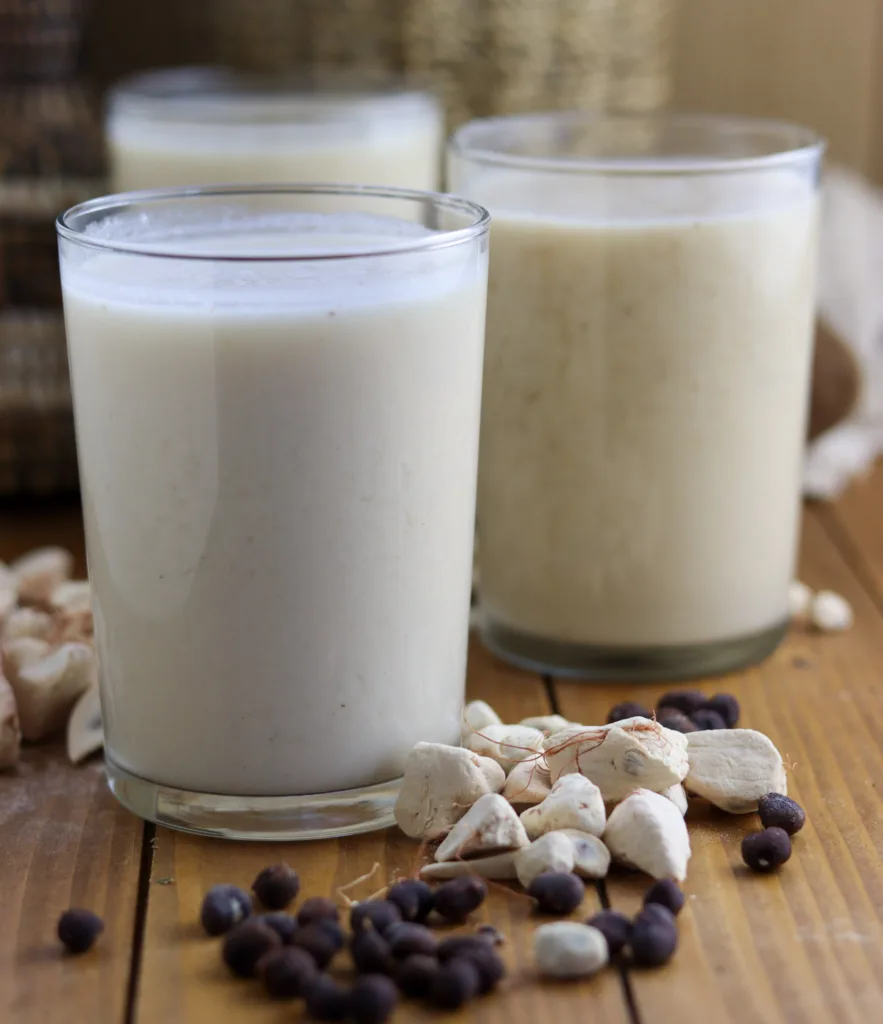
Does twice as much calcium as in a glass of milk sound like a lot? In about 100 grams of baobab fruit pulp, you can find roughly 300 to 500 milligrams of calcium.
Moreover, baobab powder contains about four times more potassium than a banana. Depending on the site where it grows, from 2,000 to 4,000 milligrams of potassium can be hidden in 100 grams of baobab powder. Pretty impressive, right?
Next, magnesium in baobab powder is about five times higher than in avocados.
And besides all the mentioned, the amazing baobab fruit also contains zinc, sodium, phosphorus and manganese.
PREBIOTIC FIBERS
Baobab is a top-notch source of natural fibers, and surprisingly – it can contain as much as 45 percent fiber! What’s even more fantastic is that this fiber is a natural prebiotic. Research indicates that consuming baobab can lead to a rise in the levels of beneficial bacteria within the digestive system, such as Lactobacilli and Bifidobacteria.
POLYPHENOLS
Baobab fruit offers a wealth of polyphenols, particularly flavonoids, which are renowned for their antioxidant capabilities. Examples of flavonoids found in baobab include tiliroside, quercetin and kaempferol. Amazingly, some sources report that baobab juice boasts a tremendous concentration of antioxidants, even more than twice the amount found in goji berries.
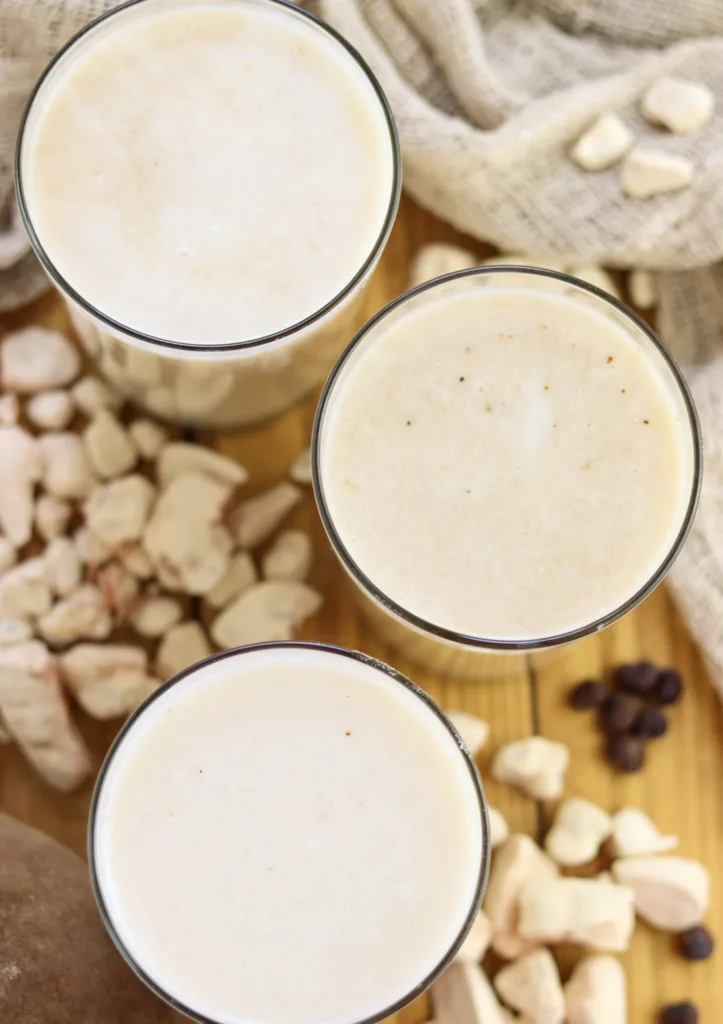
Remarkable benefits of baobab juice
BOOSTING YOUR IMMUNE SYSTEM
A rich combination of vitamins, minerals, fibers and antioxidants in baobab juice is like drinking a natural vitamin bomb. Compared to vitamin and mineral synthetic supplements on the market, natural baobab juice will be absorbed and utilized much easier and more effectively. It’s like nature’s way of saying, “Here’s everything you need to stay healthy and thriving!”
Unlike quick fixes that leave us crashing, the vitamin C in baobab juice provides a gradual and consistent flow of energy. It’s like a gentle and lasting boost, preventing those sudden tiredness spells and helping us stay alert and active throughout the day.
FIGHTING OXIDATIVE STRESS
The high vitamin C content in baobab juice is like giving your body an extra line of defense, which helps tremendously in maintaining your health and staying resistant to any unwelcome microorganisms. Vitamin C and polyphenols in baobab juice are very potent oxidative stress fighters. Protecting cells from free radicals can slow down the aging process and help you stay in top shape.
OFFERING AN AMAZING SUPPORT FOR YOUR GUT HEALTH
Prebiotic fibers in baobab juice will increase the growth of good bacteria in your gut. Prebiotics are a real treat for them, and in exchange, they help to keep your gut in great condition, ensuring your gut microbiome is balanced and healthy. This has an incredibly positive effect on your immune system and overall health.
FIGHTING INFLAMMATION
By supporting your gut microbiota, polyphenols found in baobab are transformed into powerful metabolites by your gut bacteria. These will work wonders by reducing inflammation inside your gut, which will positively affect the whole body.

REGULATING BLOOD SUGAR
Studies have also shown that baobab fruit powder has a positive impact on glycemic response, helping to regulate blood sugar levels and preventing spikes and crashes. It supports a diverse gut microbiome, which is linked to better digestion, improved nutrient absorption, and a stronger immune system.
By promoting a healthy gut microbiome and supporting steady blood sugar levels, baobab becomes a powerful ally in preventing diabetes, metabolic syndrome, digestive issues, and cardiovascular disease.
HELPING TO RETAIN HEALTHY WEIGHT
Baobab juice is a great option for those looking to lose weight. Its exceptionally high fiber content has been found to help you feel more full and satisfied for longer. Additionally, research has shown that baobab extract and powder can help promote satiety.
And guess what? Baobab prebiotic fibers seem to be like superheroes for our gut health. They’ve been shown to help absorb intestinal fat efficiently, making sure we get the most out of our food.
Our gut is like a bustling city of bacteria, with good and not-so-good residents. When there’s an imbalance, like an overpopulation of bad bacteria, it can contribute to obesity. And here’s where the baobab juice comes to the rescue.
PROMOTING COLLAGEN
The combination of antioxidants, along with the high quantity of vitamin C in baobab juice, enhances the production of collagen. This protein bolsters blood circulation to the skin, increases elasticity, and helps to keep the skin looking young. Additionally, collagen is a vital protein for the body’s structural strength.
Baobab juice, when combined with coconut milk, will be additionally enhanced with medium-chain fatty acids, particularly lauric acid. These are known for their potential antimicrobial and antiviral properties, which may contribute to supporting immune function and combating certain pathogens.
The perfect blend of ingredients in baobab juice
While many Africans prefer the taste of baobab juice with condensed milk and added artificial flavors, we fell in love with a more natural variation – baobab juice combined with organic coconut milk.
Baobab is such a precious gift of nature that it sometimes feels like a crime to mix it with artificial aromas.
What we used in this recipe and what we find as the best combination for organic juice is dry baobab pulp, coconut milk, sugar or sweetener, and, additionally, a small banana for flavor.
DRY BAOBAB PULP – The pulp used in this recipe came from a West African baobab and was bought on the street market. Organic baobab pulp usually comes with seeds and string-like seed fibers, which need to be removed before making the juice.
Baobab juice can also be made from fruit powder, where the seeds and the fibers are already removed, and the pulp is previously processed into the powder.
COCONUT MILK – When you add a cup of coconut milk to baobab juice, it gives the drink a creamy and rich texture with a subtle coconut flavor. It blends incredibly well with the tangy flavor of baobab juice and creates a pleasing blend of sweet and sour. And, of course, this way, you get even more nutrients with many health benefits.
Your baobab pulp is almost certainly wild-grown and 100% organic; that’s why we recommend spending a dime or two more and rather buying organic coconut milk as well.
What was used in this recipe was organic canned coconut milk. When using carton coconut milk instead, it’s essential to be aware of the differences in taste and texture.
Carton coconut milk tends to be thinner and lower in fat, which means your end result may not be as creamy and thick as when using canned coconut milk.
SUGAR (optional) – The choice to add sugar to baobab juice is yours. It has a distinctively tangy and citrusy flavor, which many people find to be quite enjoyable and refreshing on its own. Some may not need or want any extra sweetness to enjoy the taste.
However, in this recipe, erythritol was used as a sugar substitute. Other replacements that taste and blend well with this juice are, for example, coconut sugar and honey.
A BANANA (optional) – Instead of mixing in vanilla flavor, try blending a banana! You will be surprised how good this combination tastes.
How to make baobab juice
STEP 1: In a bowl, soak the baobab pulp in water. Stir a few times to ensure that all pieces of the pulp are covered with water.
Set aside and let nature do its job. Depending on the temperature of the place, it will take about two hours for the baobab pulp to soften and start dissolving in water.
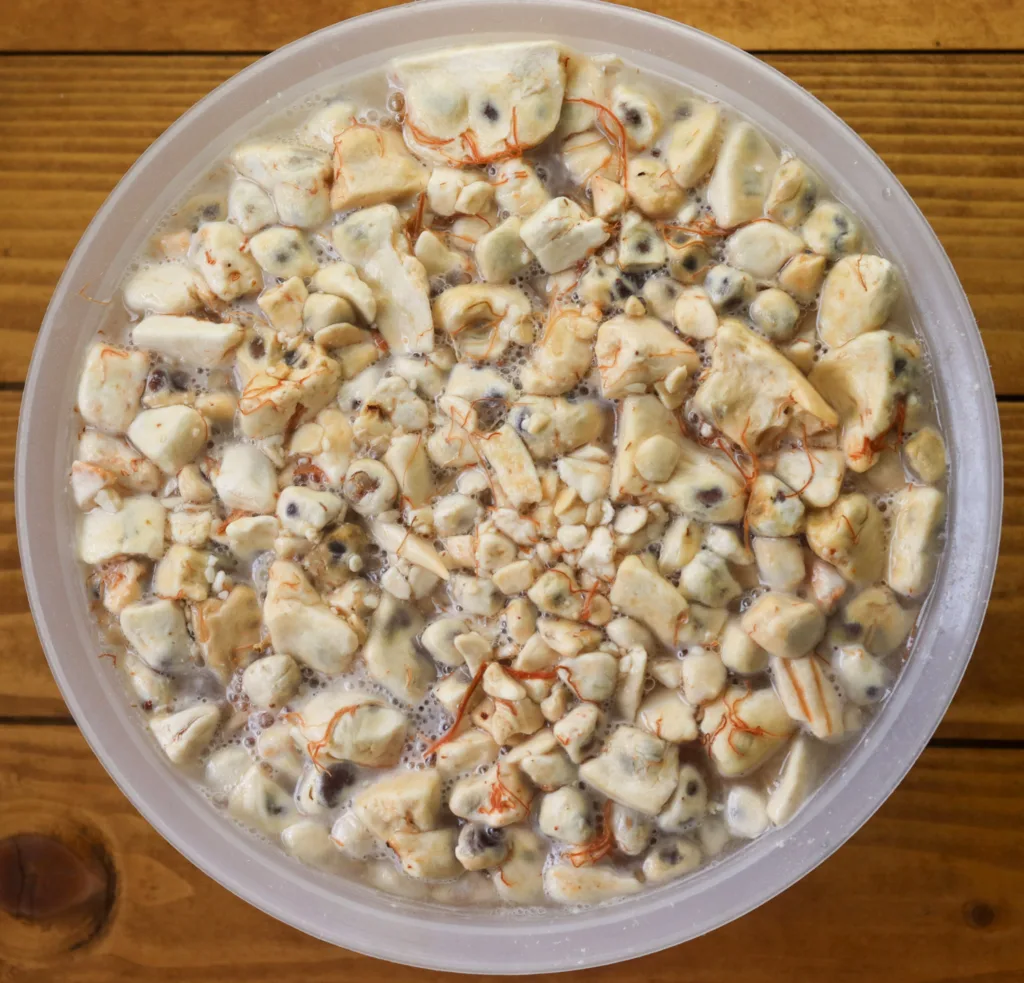
Sometimes the water will color a bit orange or reddish. That might happen if there are a lot of seed strings left inside, and it’s not something to worry about.
STEP 2: Once the pulp has sufficiently softened, it is advisable to wash your hands and squeeze it. This will help separate the pulp from the remaining seeds and seed fibers.
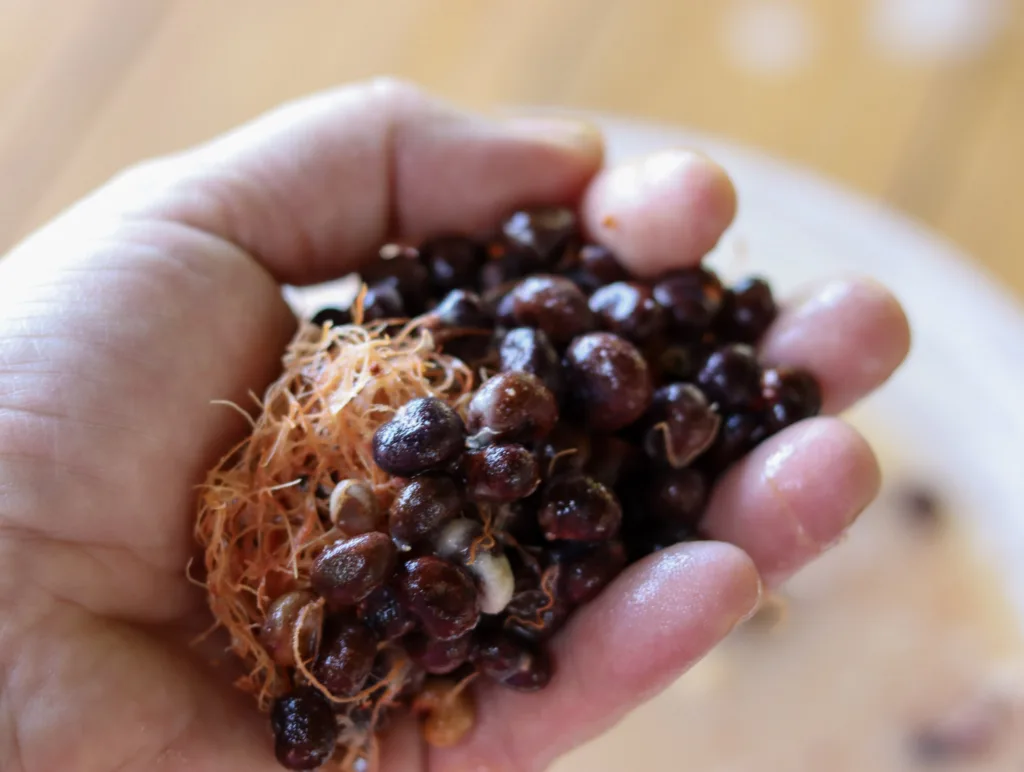
After that, repeat the process using a strainer or a clean kitchen towel to strain the juice and remove the seeds and the remains.
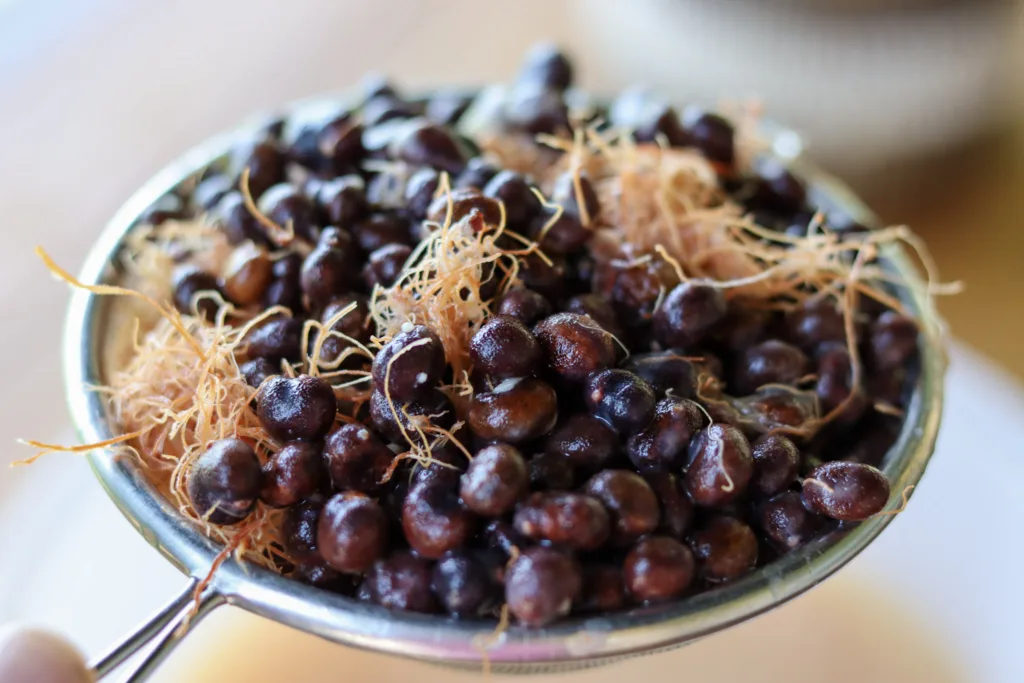
Usually, a lot of pulp will still stay in the strainer or kitchen cloth, so try not to waste it and push it through the strainer using a tablespoon.
Also, it might happen that a lot of the remaining seeds and seed fibers will also still be visible in the juice. Although these remains are not poisonous, you might want to strain the juice once again.
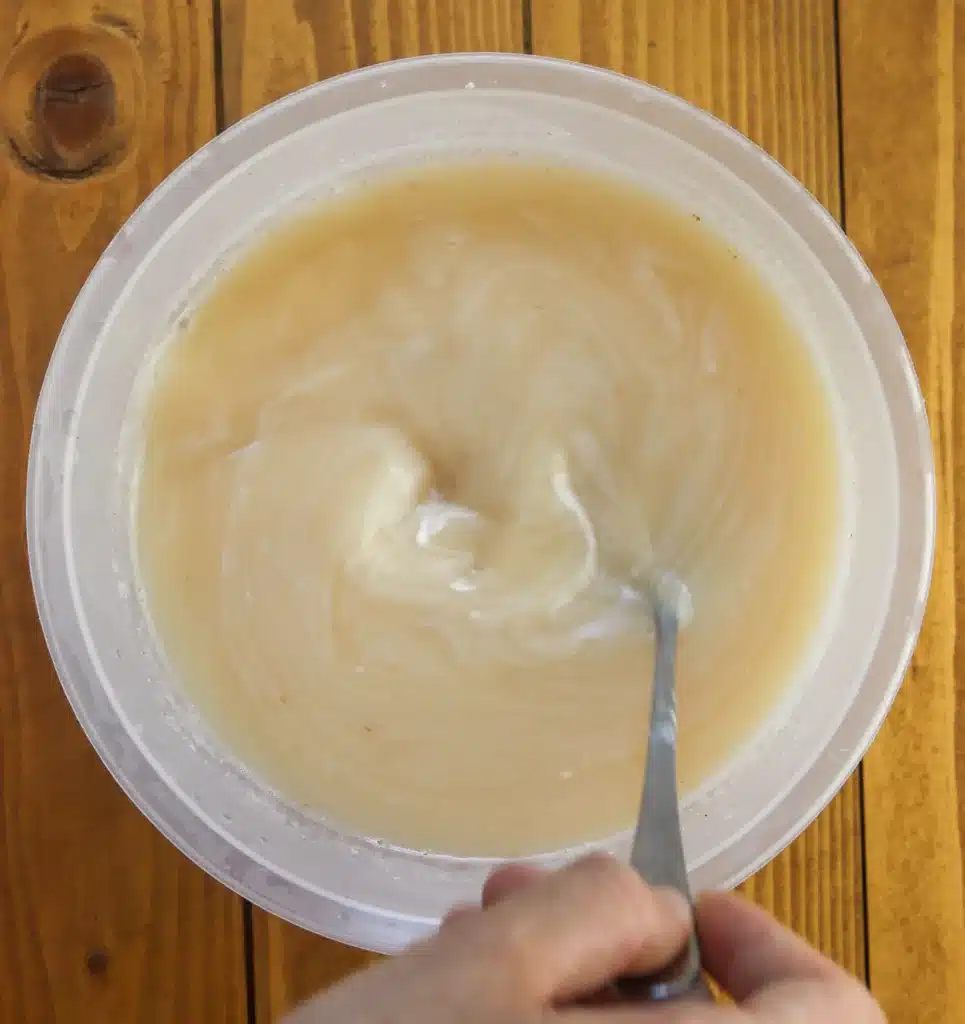
STEP 3: Adding sugar or sweeteners is of personal preference. If you want to sweeten your juice, add sugar or a replacement and stir it well to ensure it gets completely dissolved in the juice.
STEP 4: At the same time, you want to add coconut milk as well.
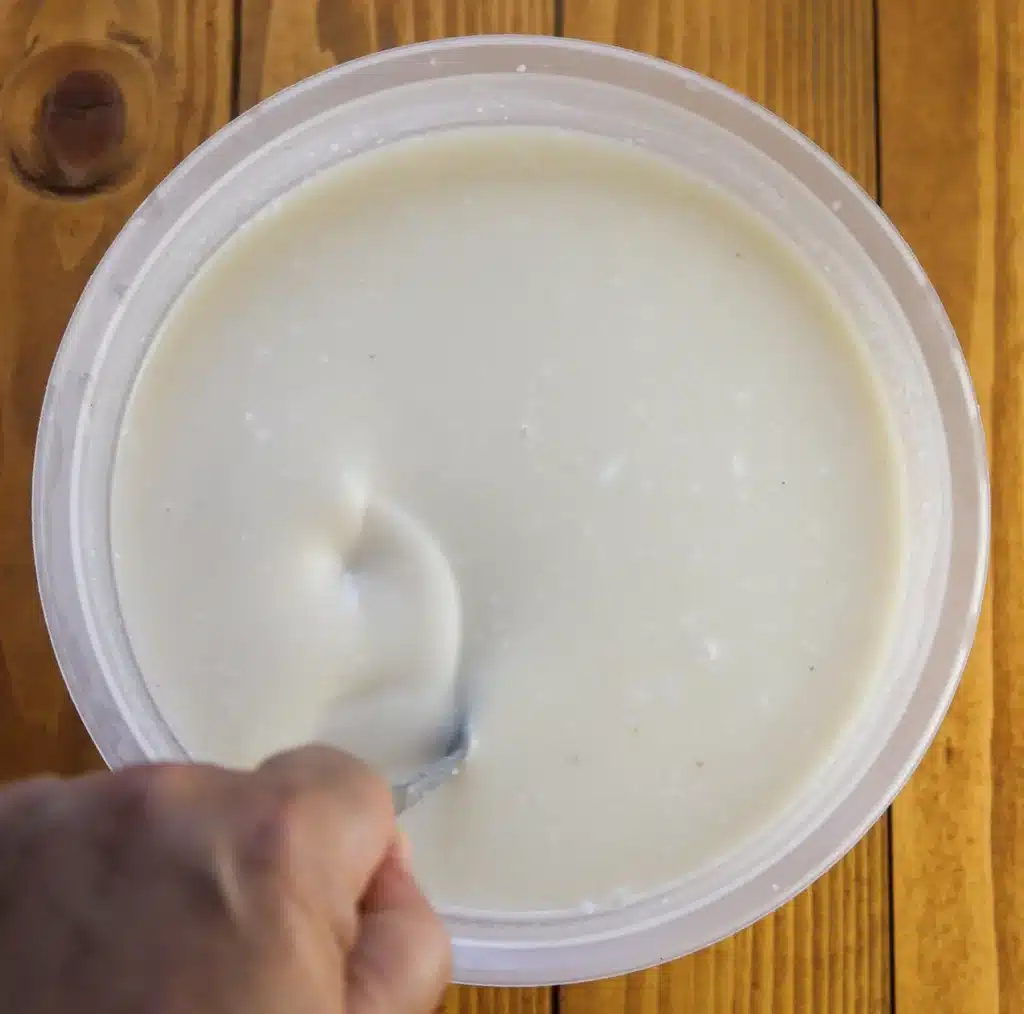
STEP 5: Once the juice is done, instead of adding an artificial flavor, which is often used in these recipes, you might want to add a more natural substitute – a small banana. It will blend perfectly with the baobab juice, and its taste adds some creaminess to the juice.
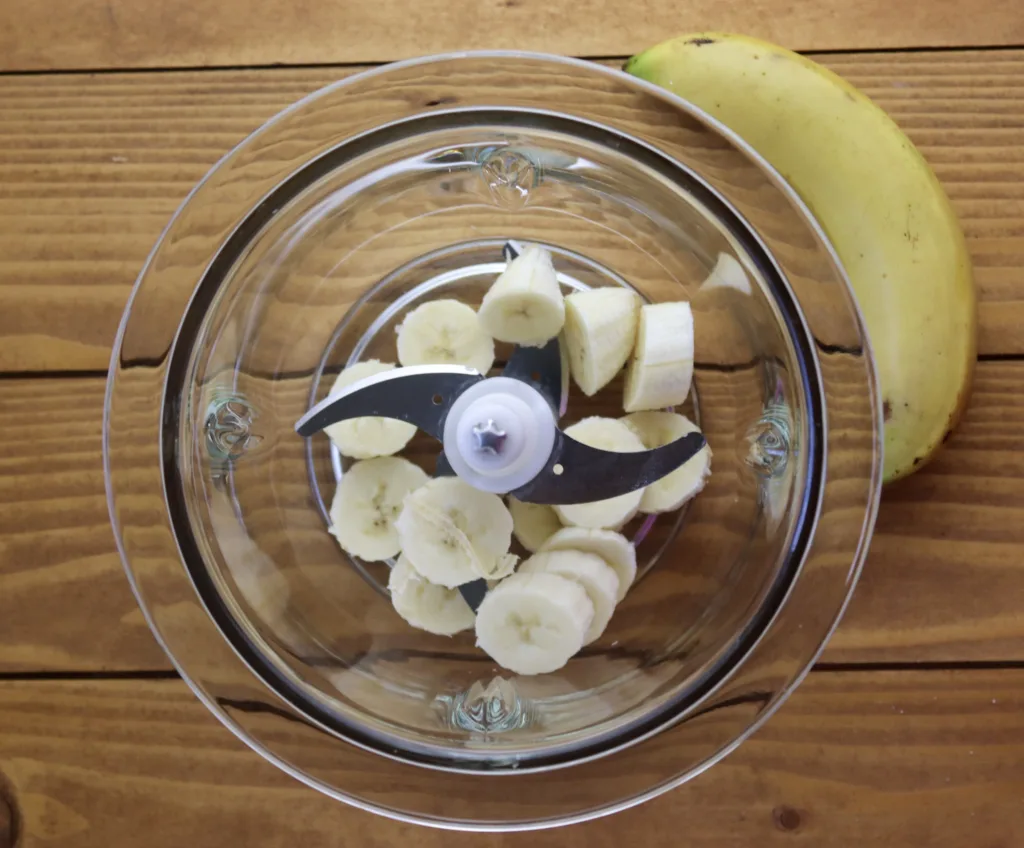
Street vendors that often sell baobab juice can’t afford to add bananas to the juice as a banana will soon turn brown in hot temperatures. However, if you keep your juice in the refrigerator, your banana won’t change color anytime soon.
The trick is that the juice tastes so good it probably won’t last long. And just in case you want to keep it longer, adding a few teaspoons of lemon juice will easily solve the problem.
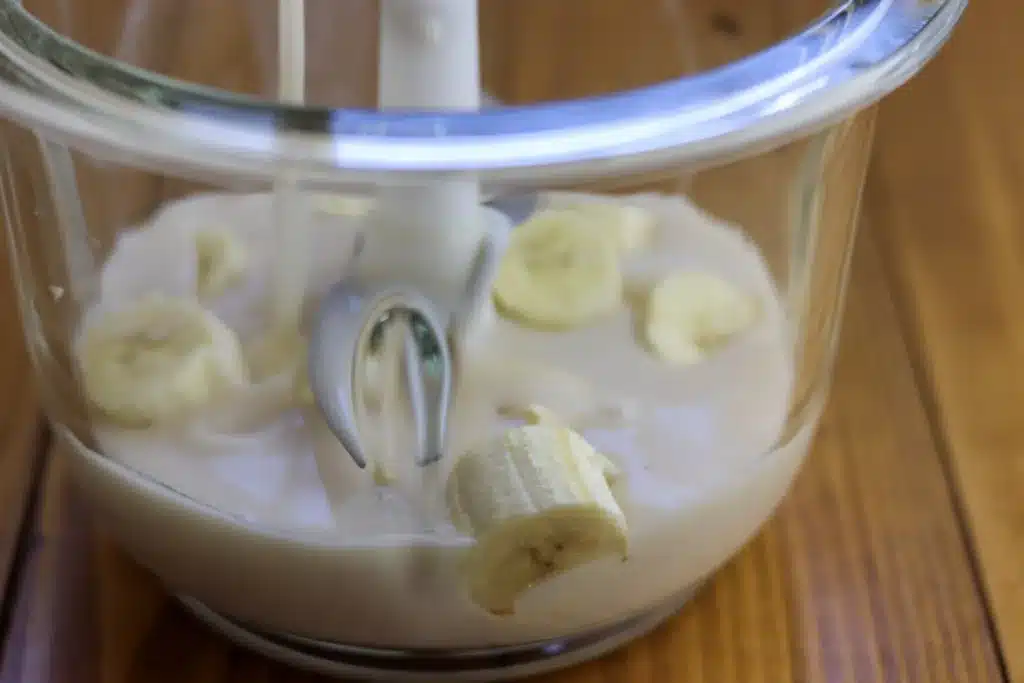
STEP 6: Lastly, store your juice in a bottle or in a mug and chill it in the refrigerator. Baobab juice definitely tastes best when served cold. Cheers!

Baobab juice variations & ideas
- Coconut milk can be replaced with condensed milk or powdered milk. Surprisingly, the citrusy flavor or added lemon juice won’t spoil condensed milk, but you need to be careful with powdered milk.
- Because of its tangy and citrusy flavor, baobab juice tastes perfect as well when mixed with other fruit juices. A few combinations that proved very tasty are pineapple, orange, mango, apple and ginger juice.
- It can be reshaped into super healthy and tasty smoothies by adding other healthy and tasty fruits, like blueberries or strawberries.
- Following a simple procedure, you can turn your baobab juice into a very delicious sorbet. Or make very special and genuine popsicles! By adding whipping or heavy cream, juice made in this recipe can be transformed into a delicious homemade baobab ice cream.
- Freezing baobab juice into ice cubes is another wonderful idea. Just add a few cubes to your cold drinks in the summer, and there you have it, a delicious ice-cold, super nutritious drink right in your hands.
- And when you get lazy, simply stir a few tablespoons of powdered baobab pulp into almost anything you can think of. Mixing it into yogurt, oatmeal, pudding, coffee, tea or fruit dressings or simply adding it to a recipe when making healthy sweets like baobab bars will generously turn your favorite food into a refreshing vitamin bomb meal.
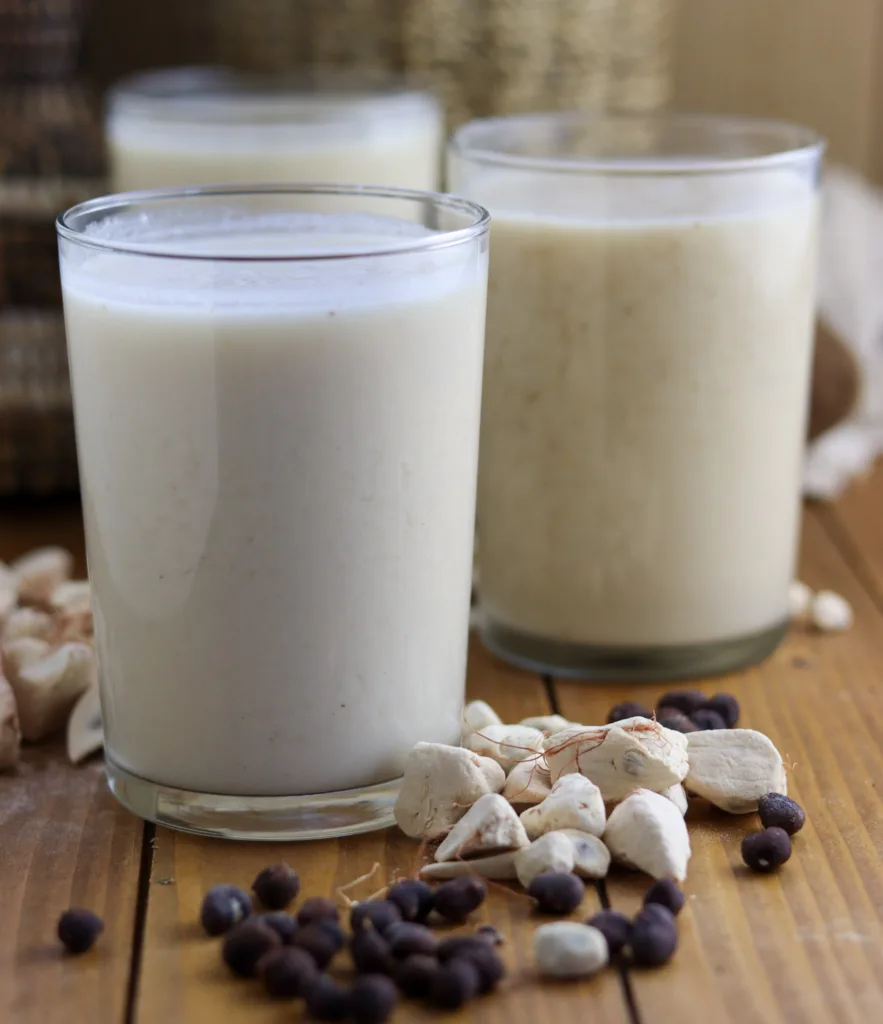
How to store baobab juice
Properly stored dry baobab pulp can be stored in a dry and cool place for up to 2-3 years, ensuring it’s packed in an airtight container or appropriate storage bag.
You can store baobab juice in a closed bottle, jar or mug in the refrigerator for up to five days. We recommend adding (chilled) bananas and other fruits right before serving.
It can be frozen and stored in the freezer for up to 8-12 months. It’s best to thaw your juice in the refrigerator overnight.
Also, baobab juice can be pasteurized at 80 C and stored in previously sterilized bottles for up to a year.
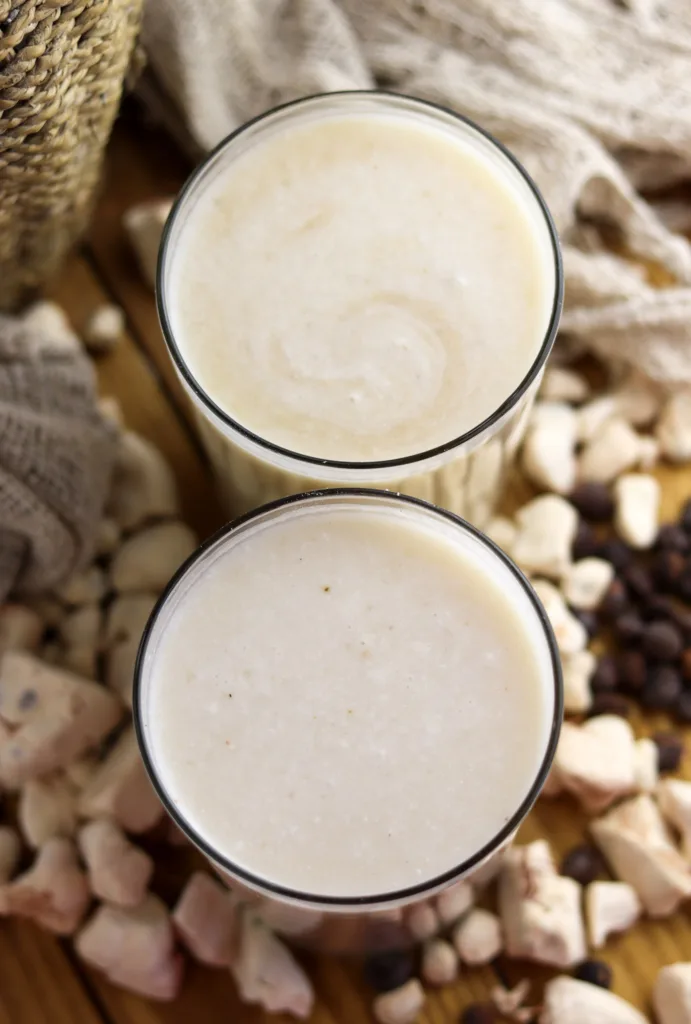
Where to find ingredients for baobab juice
Baobab fruit pulp is one of the most common things sold by street vendors in countries where baobabs grow natively. I guess I don’t remember a time when flying back from Africa and not packing some dry baobab pulp in the suitcase. This became a mandatory ritual before leaving, and I believe I’m certainly not the only one doing it.
However, when living in the US, Europe or other countries, you can buy baobab pulp in specialized stores and from many online retailers. Buying it in bulk will, many times, significantly reduce the price.
Alternatively, you can find already cleaned and processed baobab powder in food or health stores around the world.
Because dried baobab pulp usually comes together with seeds and string-like seed fibers, this adds a lot of weight to the package. It’s often cheaper to buy it in an already powdered form.
Just to remind you, baobab trees are very rarely cultivated; they are mostly grown in the wild and are usually owned by the local communities. What we recommend when buying baobab products online is to look for sustainable and responsible dealers who support the locals by donating a percentage of revenues to their communities and investing in replanting the baobab trees.
Baobabs seem to have pretty hard times because of climate change, and that, in fact, is your wonderful chance to return Africa’s amazing gift and become a guardian of these fascinating ancient giants.
Coconut milk is super easy to find and available in many places. Just head to your local grocery store, supermarket, or health food store, and you’ll likely spot it in no time.
Coconut milk comes in two forms: canned and carton. But keep this in mind – carton coconut milk tends to be thinner and less creamy compared to the canned version. Some folks find it less tasty too.
By blending shredded coconut mixed with water, you can make your own coconut milk at home.
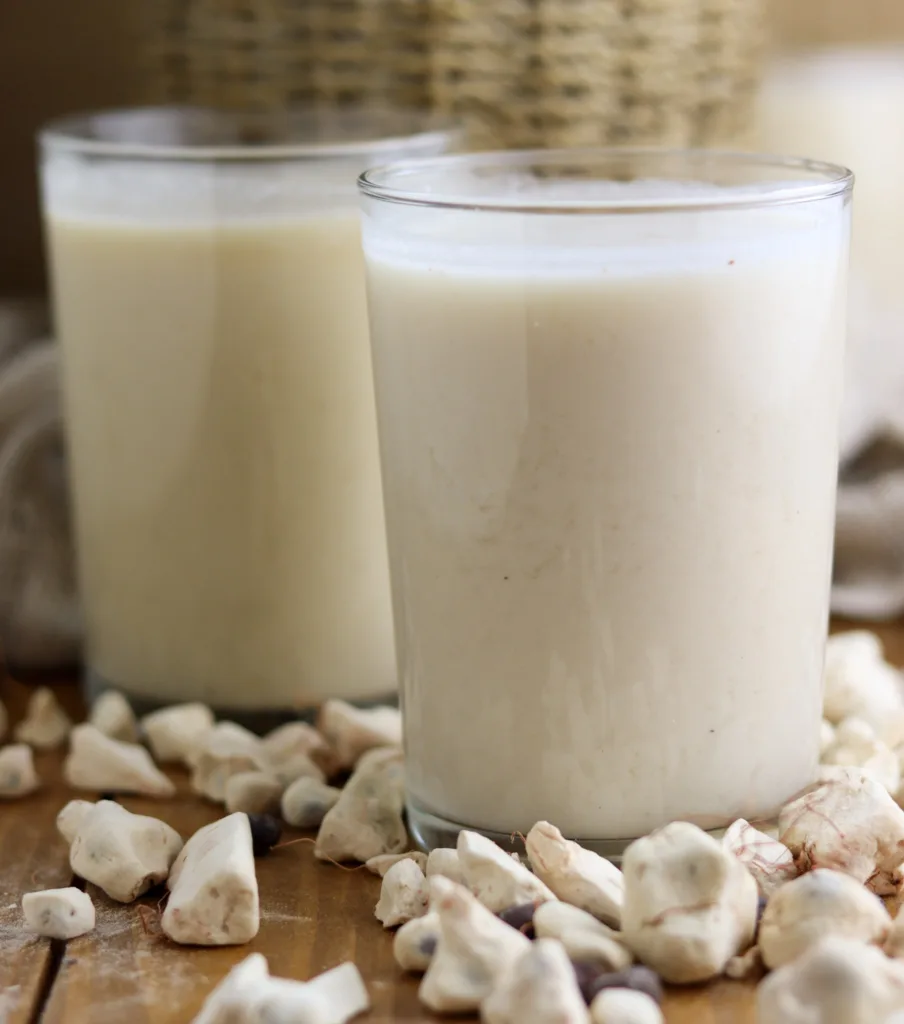
Baobab juice FAQs
Baobab juice has a very unique and refreshing taste. Lots of people describe it as tangy, citrusy, and slightly sweet. For some, it also reminds them of a tropical flavor, similar to a combination of pineapple, melon, and pear. The taste depends on the specific preparation and additional ingredients that may be added to the juice.
A glass or two of baobab juice daily won’t do any harm to your health. Any excess vitamin C will be excreted through urine.
Baobab fruit from which baobab juice is made was recognized as safe by FDA in 2009. As long as you are drinking baobab juice in reasonable amounts, there is generally no specific time limit on how long you can drink it. Although baobab is still not well researched, in countries where it grows natively, baobab juice is often drunk daily for longer periods of time.
Yes, but of course, in moderation. In some African countries, baobab juice is used to improve iron levels in children with iron deficiency. However, keep in mind that baobab juice is not a replacement for a balanced diet. Also, it’s important to choose quality baobab fruit, dilute the juice with water for younger children, be careful not to add too much sugar and be mindful of allergies. Always consult a pediatrician if needed.
Baobab juice is a rich source of micronutrients and is suitable for drinking during pregnancy; however, it should not be a replacement for a healthy diet. When buying ingredients for baobab juice, be mindful of the quality of the baobab pulp and possible allergies. Always talk to your healthcare provider before adding baobab juice or any new food to your pregnancy diet.
It is worth noting that the baobab tree is unique in that all of its parts are edible. The seeds, for instance, can be used to produce baobab seed oil, and sometimes they are used as a thickening agent in soups. The fermented seeds, on the other hand, are used for flavor enchancment, while the roasted seeds are sometimes used as a substitute for coffee. In some regions, people also consume the seed pulp, which is sold under the name of “monkey bread.”
It is important, however, to be aware that baobab seed oil contains cyclopropeonid fatty acids (CPFA), which are known to be harmful and cancerogenic. Fortunately, these acids can be reduced and broken down at high temperatures between 200°C and 250°C.
Baobab juice can be preserved in sterilized bottles for up to twelve months when it’s previously pasteurized by heating it up to 80 C for 10 minutes.
Because the dry baobab pulp from which the juice is made has a shelf life of up to three years, it’s more recommendable to store the pulp and use it to make fresh juice when needed.
It’s believed that traders from the 13th century first brought baobab from Africa to India. Baobabs can be found and even worshipped in various parts of India, such as Rajasthan, Uttar Pradesh, Madhya Pradesh, Maharashtra, and other states. Baobab trees grow abundantly in Mandu town in the Dhar district of Madhya Pradesh.
Wild-grown baobab trees will start producing fruit when they reach maturity, depending on the area they grow and especially the amount of rainfall they receive. It can take anywhere from 18 to 200 years for baobabs to begin growing fruit.
More from the food gatherer’s kitchen
How to make helichrysum oil at home
INGREDIENTS
- 300 g baobab pulp with seeds ( 0,7 lbs), or
- 150 g baobab powder without seeds (0,35 lbs)
- 1 l water (4,2 cups)
- 2,5 dcl coconut milk (1,2 cups)
- sugar or sweetener (optional)
- banana (optional)
INSTRUCTIONS
- Fill a large bowl with water, add dry baobab and soak for about two hours. Make sure that all the pulp is soaked and covered with water.
- When the pulp gets really soft and starts dissolving, squeeze it with clean hands to be able to remove the seeds and string-like seed fibers.
- Repeat the process by using a strainer or a clean kitchen towel to strain the juice once again and remove all the remains of the fibers.
- Add sugar or sweetener to taste. Stir it well until it's completely melted and mixed in the juice.
- Add coconut milk.
- Optionally, if you like the taste, add a banana using a blender or food processor.
- Chill the juice in the refrigerator and serve cold. Enjoy 🙂
Video
NOTES
- Buy quality baobab pulp from known and responsible sellers.
- If possible, buy organic ingredients.
- Store baobab juice in the fridge for up to 5 days or freeze it for up to 6 months.
- Following a simple pasteurization process, baobab juice can be heated up to 80 C for about 10 minutes and stored in sterilized bottles (in a dry and cool place) for up to a year.
- Add pure baobab juice to other juices or use it for smoothies.
- Use baobab juice for homemade ice cream, sorbet or popsicles.
- Freeze it in ice cubes and add to chill cold summer drinks.
- Burning the remaining baobab seeds may work as an effective mosquito repellent.
Nutrition
Featured at
If you liked this baobab juice recipe, please rate it in the comments below.
Show your love by sharing ❤️



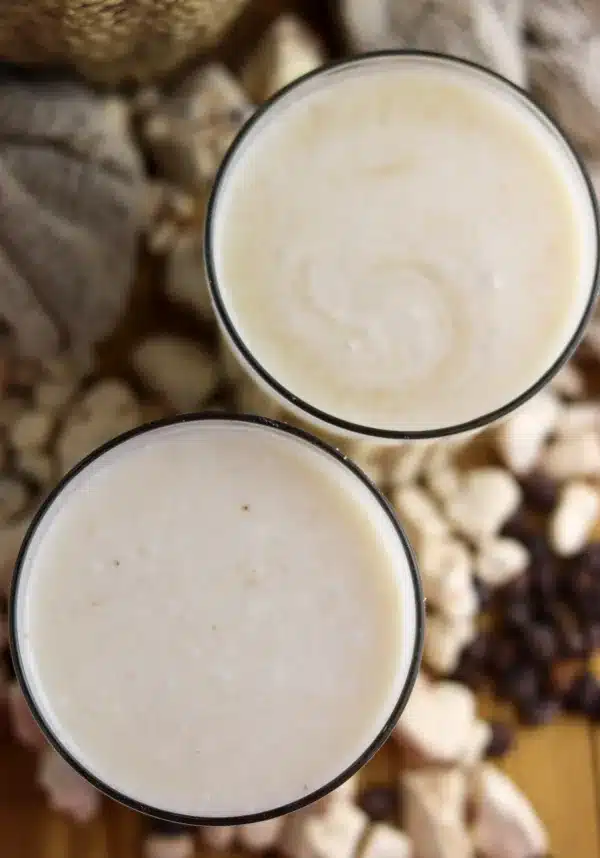
Baobab juice is an amazing drink, thank you for sharing the recipe!
Indeed, my pleasure!
Now I have learned something new, never too old to learn. Would love to try it but will have to try and find the ingredients, and not so sure that it will be available in any shape or form here in BC Canada
Thank you from your SSPS Team for sharing your links with us at #271 SSPS Linky.
No worries Esme, you have plenty of baobab powder these days practicaly everywhere. I don’t want to advertise the retailers, but I’m sure every health store has it, otherwise you can easily order it online. For baobab pulp check Etsy, plenty of sellers there. Cheers!
I don’t think I have ever heard of Baobab juice yet alone tried it but it sounds so good! How interesting to read all about it. x
Hi Kim, I strongly encourage you to try it, baobabs are indeed special and the juice is also as incredible as the tree itself.
This was a fascinating post to read and learn a lot; thank you for the background and information about baobabs and the recipe, cheers!
Thanks Irene, I hope you try it, you’ll be suprised, it’s trully an amazing drink.
Fascinating! I wondered what Baobab juice was! 🙂 Stopping by from #inspirememonday
Indeed, baobabs are some very special trees. Hope you’ll give it a try!
Oh my goodness this sounds fantastic! Wow thanks for giving this great history and information today.
Visiting today from PoCoLo #3
Thanks Paula 🙂
“And if the planet is too small and the baobabs become large, they will make it shatter.” I guess Antoine de Saint-Exupéry never tried baobab juice! Thanks Anne 🙂
I didn’t realise there were so may uses from the Baobabs trees. I’ve since a few from my time living in South Africa and travelling to the north. Thanks for linking with #pocolo
Very true, baobabs have so many uses that it’s a real shame that they are dying. You might want to follow us for the next adventure – baobab ice cream 🙂
I have never heard of baobab juice before so I learned something new today. I will have to check this out. Thank you for sharing with Whimsy Home Wednesday.
I’m very happy that you did and hope you’ll try it 🙂
I don’t think I have heard of Baobab juice before, but I’d love to try it someday. Thanks a bunch for sharing this informational post and for joining Fiesta Friday party!
With pleasure, I definitely want to encourage you to try it.
Fascinating to find out more about baobab trees but how awful that they are dying off due to climate change. I’ve never tried baobab juice – it sounds like it has some amazing nutritional properties. #WotW
Hi Angie, I strongly encourage you to try it, baobabs are truly amazing plants and the fruits have so many benefits. I guess more people know about baobabs, more effort will be put in preserving them.
Wow, there are so many great benefits to Baobab. I learned a lot today. That is amazing that the tree can live up to 3000 years. No wonder they are called the Tree of Life. Simply amazing. The recipe sounds wonderful. Can it be done with almond milk as well? Thank you for sharing the recipe, and great detail on Baobab.
Hi Stephanie, yes you can use almond milk instead of coconut milk, the juice won’t be as creamy as made with coconut milk, but it does have a nice taste. Btw, I agree, these awesome giants definetly deserve more attention.
I have never tried baobab juice but after reading your article, I need to head out and get one right away! I just thought it was a novelty drink, I wasn’t aware of the history behind baobab and the added health benefits! A seriously great post! Sim x Hopping over from #MMBC
Indeed, we mostly hear about baobab powder when health stores bombard you with ads and usualy we don’t even know what that is. If I wouldn’t see these beautiful trees myself I would never buy that powder. But, baobabs are really amazing and magical ancient trees which truly deserve so much more attention than they get right now. Thanks!